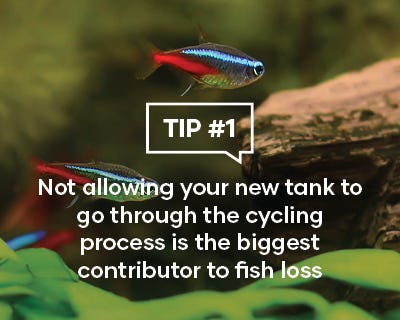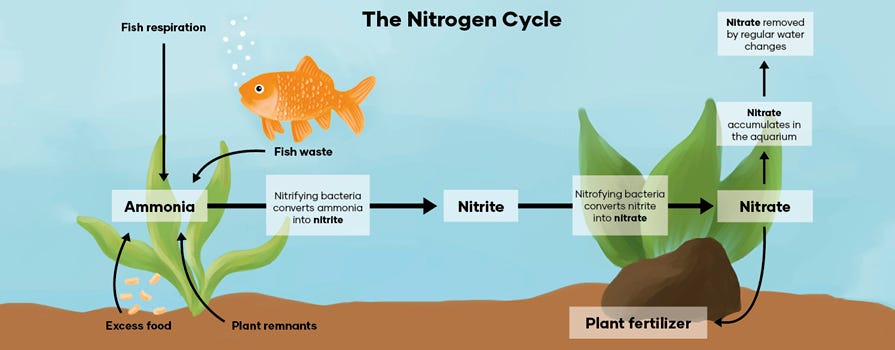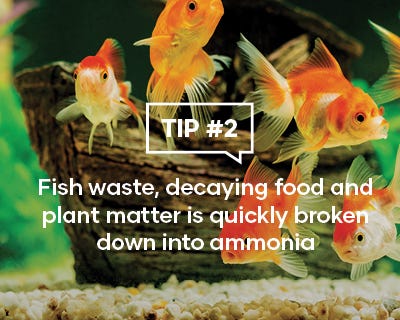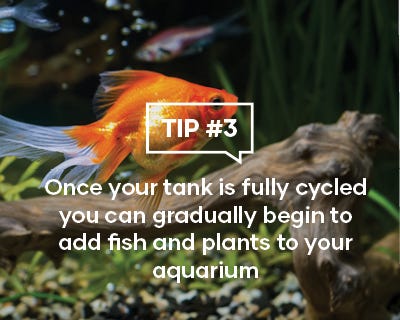The Nitrogen Cycle
The Nitrogen Cycle is a necessary process that every new tank must go through. It is a chain of biological reactions that produce chemical results which revolves around fish/plant waste.

All living creatures produce waste products. These nitrogenous products naturally break down into ammonia. Ammonia even in low levels is toxic to fish. In nature, the volume of water per fish is very highand therefore any toxins are diluted but in your household aquarium, any toxins become concentrated quickly, so the water chemistry must be controlled in order for your fish to live healthy lives.
Cycling the tank refers to the process of establishing beneficial bacterial colonies in the tank (concentrated mostly in the filter) that convert harmful ammonia to nitrite and then Nitrate. This process can take five to seven weeks (in tropical tanks and even a little longer in cold water tanks) to sustain a full biological load, so patience and vigilance are required. Not allowing your new tank to go through this cycling process is the biggest contributor to fish loss. We would recommend reading our article on Setting up your new aquarium before you start.
Understanding the process and how to deal with it will greatly increase success and enjoyment in your fish keeping journey.

How to start the Nitrogen Cycle
The Nitrogen Cycle begins when a bacterial source (ammonia) is introduced to the aquarium. We recommend cycling your aquarium with a source of ammonia such as pure ammonia or something that will break down and create ammonia such as fish food. Don't be tempted to add fish into your aquarium until the cycle is completed.

Stages of the Nitrogen Cycle
There are three stages of the Nitrogen Cycle:
Stage one
Fish waste, decaying food and plant matter is quickly broken down into ammonia. Ammonia is toxic to fish even in small doses, which is why introducing fish too early is a big contributor to mortalities in your aquarium.
During this stage, you should test your water three days after adding your ammonia source, and then continue to monitor this daily until you start to see the ammonia levels dropping.
Stage two
Nitrifying bacteria forms which converts the ammonia intro Nitrite. Nitrite is also toxic to fish even in small doses.
Once the ammonia levels start to drop, you should instead start to see the Nitrite levels rising. You should start to see the second stage starting within two weeks of introducing your ammonia source. Continue to test every second or third day until you again start to see the Nitrite levels begin to drop.

Stage three
More Nitrifying bacteria forms and converts the Nitrite into Nitrate. Nitrate is not toxic to fish unless in large quantities.
Routine partial water changes will keep the Nitrate levels within a safe range. Live aquatic plants in established tanks will also aid in keeping your Nitrate levels within a safe range. Testing and monitoring your tank and fish health at this critical stage will make the start of your fish keeping journey a manageable one.
Your tank is fully cycled once the ammonia or Nitrite levels are testing at <0ppm and once Nitrates are being produced in safe levels (<20ppm). You can gradually begin to add fish and plants to your aquarium, but remember to keep an eye on these levels as ammonia can spike if the amount of nitrifying bacteria isn't enough to handle the biological load of the fish or plants.
Top tips for cycling your aquarium:
- Don't rinse the filter media with tap water. The chlorine in the tap water will kill any good bacteria living in the filter media. If you need to rinse the filter media, we recommend rinsing it in tank water that you have syphoned out during your water change routine.
- Don't try to alter the pH of your aquarium. Beneficial bacteria can be negatively affected by changes in pH as it can cause the toxicity of the ammonia to fluctuate. Unless there is a serious problem with the pH, leave it alone during the cycling process.
- Invest in a testing kit. During the cycling process, you want to be testing your aquarium water regularly so you can see where in the Nitrogen Cycle your aquarium is currently sitting, and if there have been any dangerous spikes or unusual dips. Alternatively you can pop into your local Animates store who can test your aquarium water for free - bring the water sample in a clean glass jar to ensure no contamination.
- Utilise products like Nutrafin Cycle. This is bottled beneficial bacteria, and can be of aid to you in the Nitrogen Cycle by giving a boost of bacteria.
Recommended supplies:
- Filtration
- Test kit
- Beneficial bacteria
- Water conditioner



